Assessment of Impacts
Introduction
This chapter provides a high-level assessment of the potential impacts of Full Dualling and the packages of transport intervention options that are being considered as part of the A96 Corridor Review on children and young people.
The assessment is based on the rating criteria set out in Section 5.3 and takes into account wider appraisal work and baseline evidence for children and young people.
For the purposes of the A96 Corridor Review, the ‘With Policy’ and ‘Without Policy’ scenarios developed as part of the scenario planning undertaken for STPR2 are used in the Detailed Appraisal of Full Dualling and each package. These scenarios were developed to consider the risk associated with future uncertainties. The following two scenarios with their inherent variants of transport behaviour were considered:
- 'With Policy Scenario' - captures policy ambitions including 20% reduction (from 2019 levels) in car kilometres travelled by 2030, and assumptions to significantly reduce levels of commuting/business journeys to reflect post COVID-19 working behaviours, leading to low levels of motorised traffic demand and emissions.
- 'Without Policy Scenario' - no policy ambitions are captured, and less significant reductions to levels of commuting/business journeys, leading to higher levels of motorised traffic demand and emissions.
Transport Intervention Packages
Full package descriptions and detailed appraisal summaries are included within the ‘Strategic Business Case – Transport Appraisal Report’ published alongside this CRWIA. However, Table 6-1 provides a summary of the transport interventions included within each package. It should be noted that the A96 Dualling Inverness to Nairn (including Nairn Bypass) scheme does not form part of the A96 Corridor Review as it has successfully progressed through a Public Local Inquiry and has Ministerial consent. Interventions within Nairn itself, similar to those proposed within the other bypassed towns, however, have been included within the packages for appraisal purposes.
Table 6‑1: Interventions within Each Detailed Appraisal Package
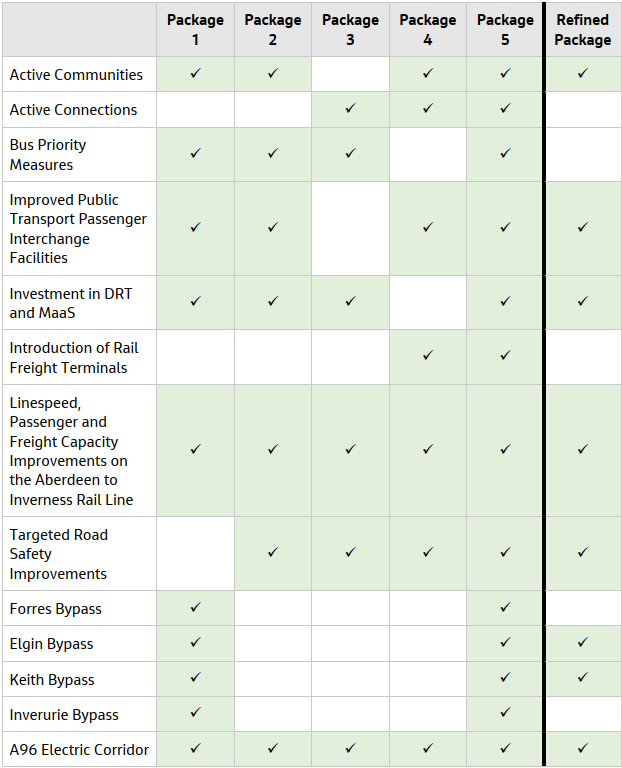
A96 Full Dualling – Potential Impacts
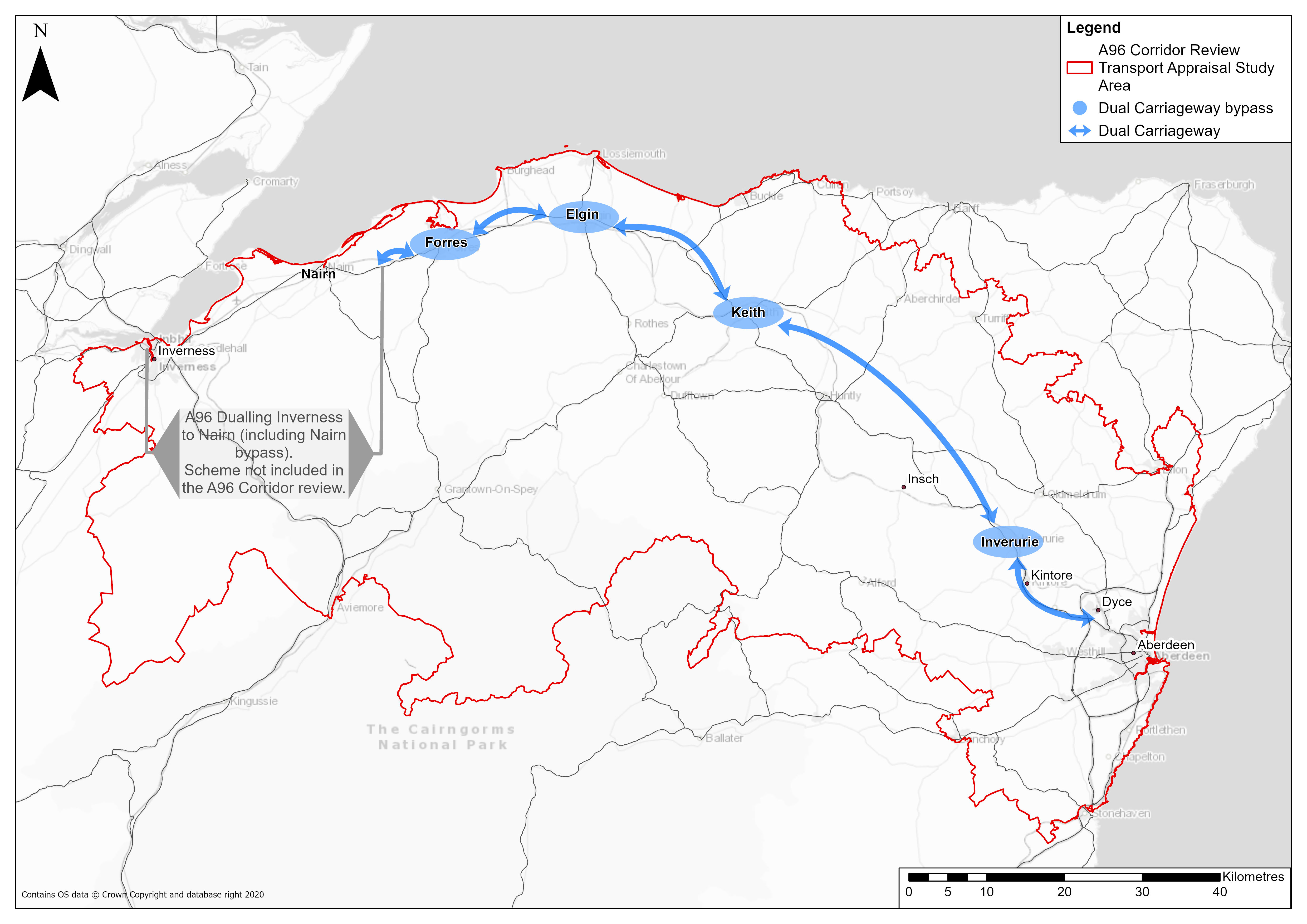
Figure 6‑1: A96 Full Dualling Hardmuir to Craibstone extent
The provision of a dual carriageway could potentially result in adverse health outcomes for children living in local communities along the corridor. This includes noise, vibration and air quality impacts during construction and potential severance, noise, air quality and traffic impacts due to an increase in motorised vehicles travelling on the A96 during operation. Air quality modelling forecasts show that as a result of increased traffic flows and an attraction of traffic to the corridor, nitrogen dioxides (NOx) and particulate matter (PM) 2.5 emissions are predicted to increase over the 60-year appraisal period across the ‘With Policy’ and ‘Without Policy’ scenarios.
However, the dual carriageway is anticipated to require towns to be bypassed. Traffic modelling forecasts predict that traffic would divert away from Elgin, Keith and Inverurie as a result of full dualling in both the ‘With Policy’ and ‘Without Policy’ scenarios. Therefore, a reduction in traffic through communities could result in improved local air quality and reduced traffic noise which would be a particular benefit to children, as they are more vulnerable to the adverse health effects of traffic-related emissions and traffic noise. Reduced traffic levels could also help to address local severance issues, improve the active travel environment, reduce road safety concerns, and improve access to education for children and young people.
While the negative impacts of construction and operation are not expected to outweigh the positive impacts of connectivity and bypasses, the level of direct impact will be dependent on the alignment of the route and proximity to children and young people living or attending schools along the route. More detailed assessment is required at the design stage to understand the extent of these impacts and to recommend effective mitigation.
Overall, this option is expected to have a minor positive impact on this criterion under both the ‘With Policy’ and ‘Without Policy’ scenarios.
Package 1 – Potential Impacts
This package is focused on primarily delivering transport network improvements to key towns along the A96 corridor, namely Nairn, Forres, Elgin, Keith and Inverurie, by providing enhancements which would aim to encourage a shift to sustainable modes, increasing opportunities for residents and businesses and improving road safety.
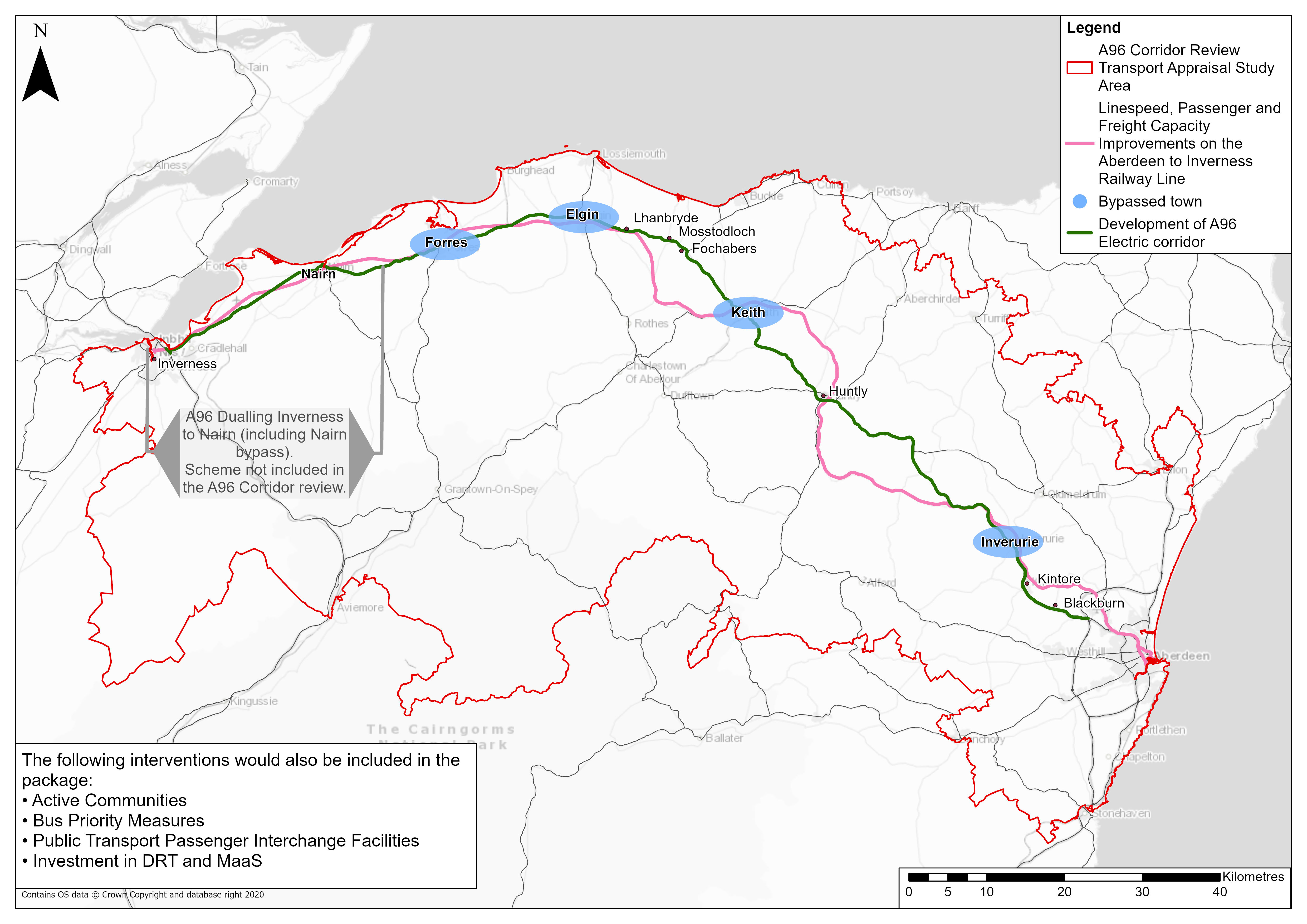
Figure 6‑2: Package 1 Extent
NaPTAT modelling also shows that the improved journey time accessibility of educational premises would largely be observed in Aberdeenshire, where an additional 1,000 young people aged 16-24 would be able to access their nearest higher education site in approximately 60 minutes by public transport. These accessibility improvements would be linked to the rail linespeed improvements from the package, reducing the travel time to the cities where higher and further education sites are largely located. Further benefits would be provided from the improved interchange facilities and bus priority measures within the package, which would improve the connection between services or reduce journey times associated with bus. The largest journey time benefits would be observed in rural settlements with access to rail stations, including Insch (located approximately 12 miles to the north-west of Inverurie) with a reduction of 8 minutes and Alford (located to the south-west of Inverurie) with a reduction of up to 17 minutes to the nearest site, though the latter would require undertaking part of the journey by bus, while parts of Kintore observed a journey time benefit of up to six minutes.
In rural areas, children and young people may experience longer walks to bus stops, infrequent services and long waiting times for connecting services. An increase in Demand Responsive Transport (DRT) and Mobility as a Service (MaaS) could help to improve connectivity for children and young people, improving access to key services such as education. Improved connectivity could also result in improved personal safety and security through more direct services between origins and destinations. This improved provision would supplement the benefit of free bus travel for 5–22 year-olds with a National Entitlement Card (NEC). However, some children may still be excluded without the appropriate level of support to apply for an NEC.
While air quality modelling forecasts that Package 1 would result in adverse air quality emissions over the 60-year appraisal period, there is potential for improvements in air quality in bypassed towns through a reduction of through traffic and an uptake of active travel, which could also reduce traffic noise within the towns. This would be of particular benefit to children as they are more vulnerable to the adverse health effects of traffic-related emissions and noise. Reduced traffic levels could also help to address local severance issues, improve the active travel environment, reduce road safety concerns and improve access to education for children and young people. In addition, the habit-forming effect of embedding active travel at a younger age has the potential to have longer-term benefits, in terms of moving to a more active population.
However, the construction of new bypasses could potentially result in negative impacts during both construction and operation stages for children living in local communities along the new alignment. These include noise, vibration and air quality impacts during construction and potential severance, noise, air quality and traffic impacts during operation . However, the level of direct impact would be dependent on the alignment of the bypass and proximity to children and young people living or attending schools along the route. More detailed assessment is required at the design stage to understand the extent of these impacts and to recommend effective mitigation. Impacts would also depend on the level to which all other listed interventions can be adopted, as it is noted that this would depend on local circumstances within each key community .
Overall, this package is expected to have a moderate positive impact under both the ‘With Policy’ and ‘Without Policy’ scenarios on addressing this criterion for children and young people.
Package 2 – Potential Impacts
This package of interventions is targeted at providing network improvements to some of the less populated settlements along the A96 corridor, that are not suggested to be bypassed within Package 1. The package would provide enhancements which would aim to encourage a shift to sustainable modes, increase opportunities for residents and businesses, and improve road safety.
The specific settlements considered in this package are Lhanbryde, Mosstodloch, Fochabers, Huntly, Kintore and Blackburn and are shown within the context of the wider A96 Corridor Review transport appraisal study area in Figure 6-3 . This package focuses on delivering transport network improvements within the vicinity of these towns, aiming to encourage a transfer to sustainable modes and improve road safety. Whilst this package is primarily targeted at the aforementioned settlements, the package also includes corridor wide interventions which are anticipated to result in benefits to other areas within the corridor.

Modelling undertaken using NaPTAT anticipates that this package would improve public transport connectivity to higher and further education in the study area, which could have particular beneficial impacts on children and young people, given 16% of children travel to school by bus. Furthermore, children and young people may be more likely to depend on buses for leisure travel, given that those under 17 are unable to drive.
NaPTAT modelling shows that the improved journey time accessibility of educational premises would largely be observed in Aberdeenshire, where it is anticipated an additional 900 young people aged 16-24 would be able to access their nearest higher education site in approximately 60 minutes or less by public transport. These accessibility improvements would be linked to the rail linespeed improvements from the package, reducing the travel time to the cities where higher and further education sites are largely located. Further benefits would be provided from the improved interchange facilities and bus priority measures within the package, which would improve the connection between services or reduce journey times associated with bus. While smaller rural settlements, such as Insch and parts of Kintore, would experience a journey time reduction of up to eight and seven minutes respectively to the nearest higher education site, benefitting 600 young people.
In rural areas, children and young people may experience longer walks to bus stops, infrequent services and long waiting times for connecting services. An increase in DRT and MaaS could help to improve connectivity for children and young people, improving access to key services such as education. Improved connectivity could also result in improved personal safety and security through more direct services between origins and destinations. This improved provision would supplement the benefit of free bus travel for 5–22 year-olds with a National Entitlement Card (NEC). However, some children may still be excluded without the appropriate level of support to apply for an NEC.
Air quality modelling forecasts that this package would result in improved air quality across the 60-year appraisal period as a result of reduced congestion as a result of modal shift, which should contribute towards a reduction in traffic volumes. This would be of particular benefit to children as they are more vulnerable to the adverse health effects of traffic-related emissions and traffic noise. Reduced traffic levels could also help to address local severance issues, improve the active travel environment, reduce road safety concerns and improve access to education for children and young people. In addition, the habit-forming effect of embedding active travel at a younger age has the potential to have longer-term benefits, in terms of moving to a more active population.
However, the extent to which this package would improve outcomes for children would depend on the extent that the interventions listed are adopted (especially in regard to the reallocation of road space and other safety interventions), the location of the interventions, and proximity to local services. The relatively small population of the settlements considered in this package is likely to limit the impact the potential outcomes for children in the context of the wider corridor.
Overall, this package is expected to have a minor positive impact on addressing this criterion in both ‘With Policy’ and ‘Without Policy’ scenarios.
Package 3 – Potential Impacts
This package is focused on primarily delivering transport network improvements to rural sections along the A96 corridor by providing enhancements which would aim to encourage a shift to sustainable modes, increase active travel and public transport options and improve road safety.
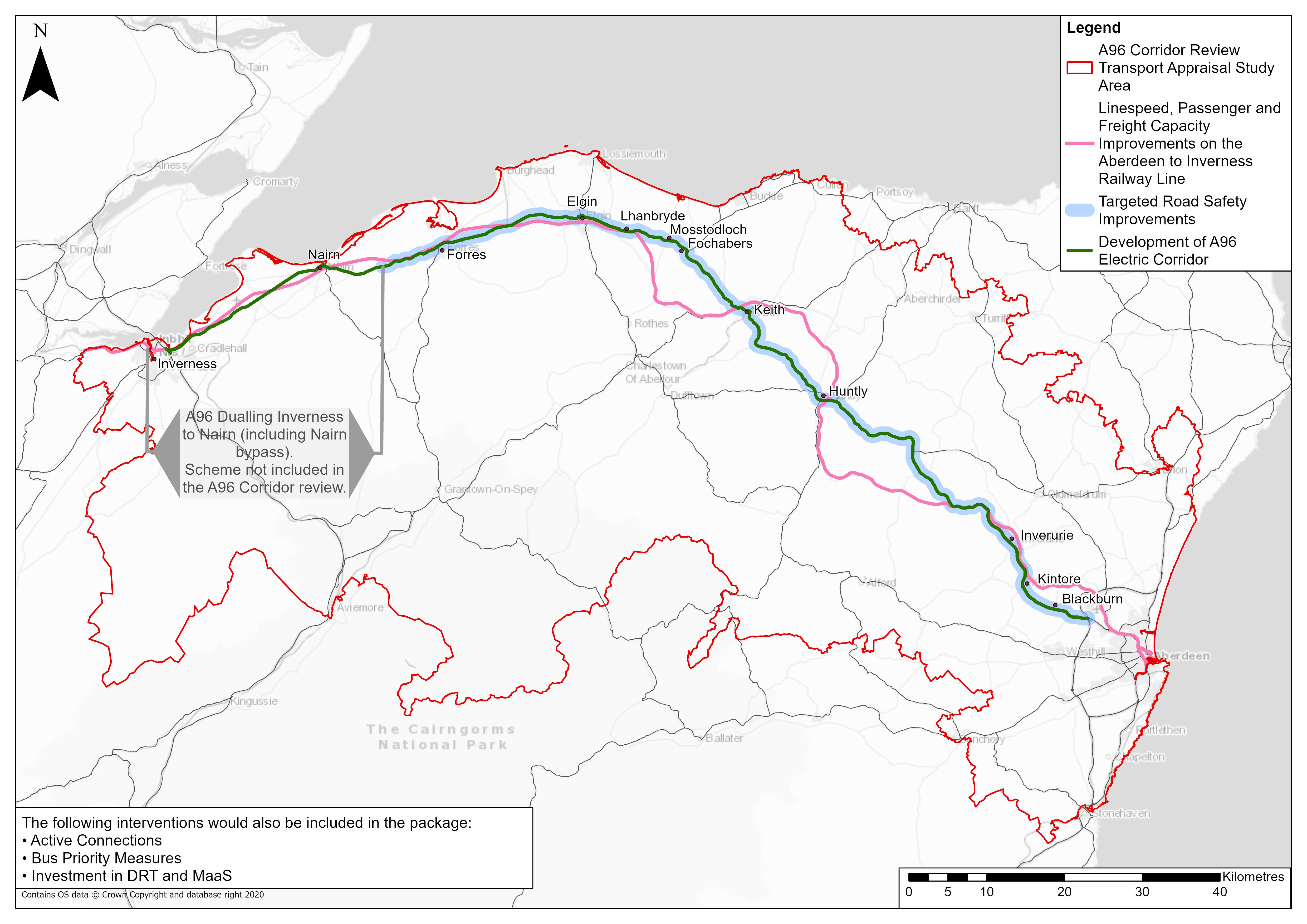
Figure 6‑4: Package 3 Extents
NaPTAT modelling showed that improved journey time accessibility of educational premises would largely be observed in Aberdeenshire, where it is anticipated an additional 750 young people aged 16-24 would be able to access their nearest higher education site in approximately 60 minutes using public transport. These accessibility benefits would be linked to the rail linespeed improvements and bus priority measures on the approaches to cities from the package. While smaller rural settlements, such as Insch and parts of Kintore, would be predicted to experience a journey time reduction of up to seven minutes to the nearest higher education site, benefitting 600 young people.
In rural areas, children and young people may experience longer walks to bus stops, infrequent services and long waiting times for connecting services. An increase in DRT and MaaS could help improve connectivity for children and young people, improving access to key services such as education. Improved connectivity could also result in improved personal safety and security through more direct services between origins and destinations. This improved provision would supplement the benefit of free bus travel for 5–22-year-olds with a National Entitlement Card (NEC). However, some children may still be excluded without the appropriate level of support to apply for an NEC.
Air quality modelling forecasts that this package would result in improved air quality across the 60-year appraisal period as a result of modal shift, which could reduce congestion. This would be of particular benefit to children as they are more vulnerable to the adverse health effects of traffic-related emissions and traffic noise. Reduced traffic levels could also help to address local severance issues, improve the active travel environment, reduce road safety concerns, and improve access to education for children and young people. In addition, the habit-forming effect of embedding active travel at a younger age has the potential to have longer term benefits, in terms of moving to a more active population.
However, the extent to which this option would improve outcomes for children would depend on the extent that the interventions listed are adopted, the location of the interventions, and proximity to local services in rural areas.
Overall, this package is expected to have a minor positive impact on addressing this criterion in both ‘With Policy’ and ‘Without Policy’ scenarios .
Package 4 – Potential Impacts
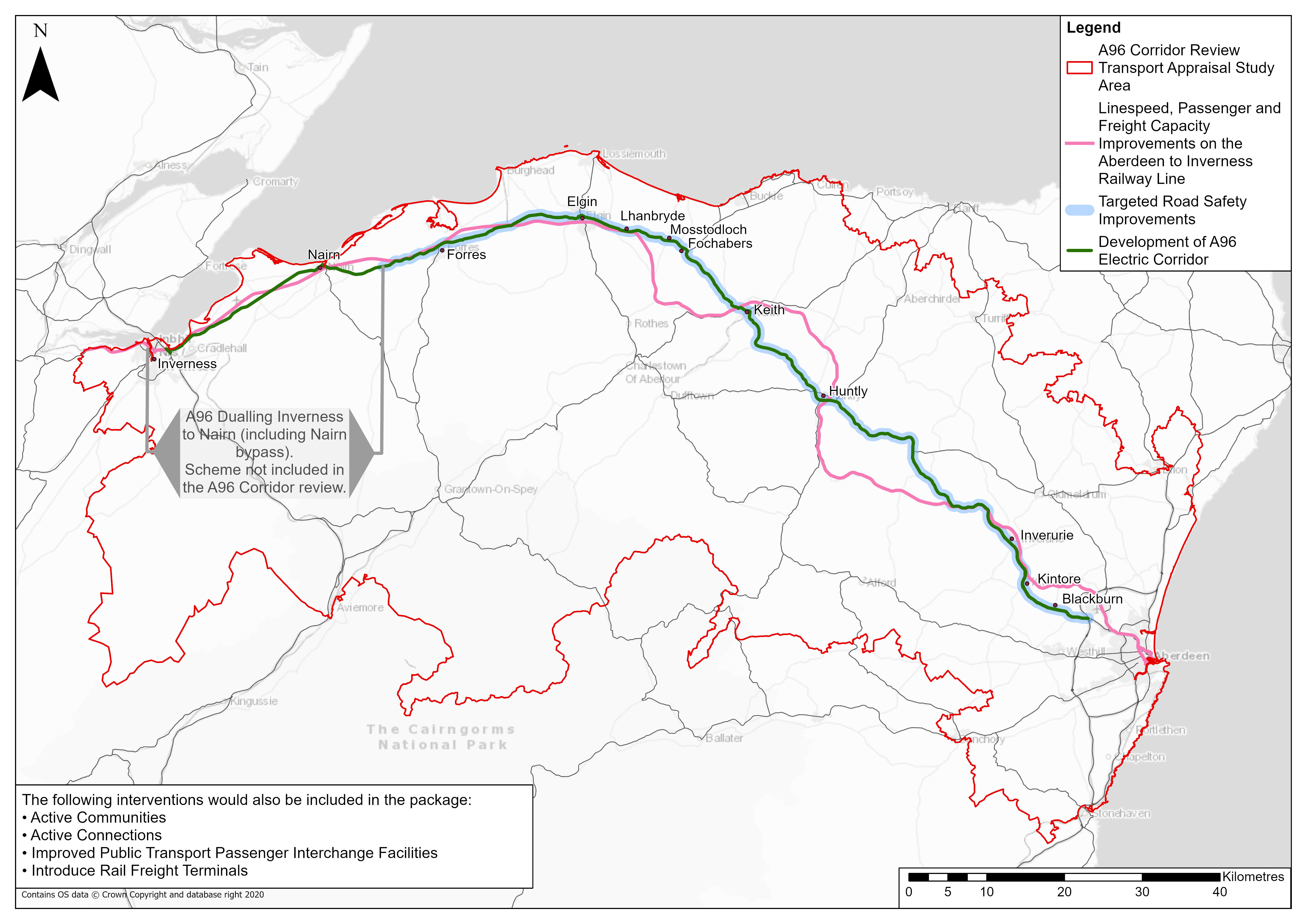
Figure 6-5: Package 4 Extents
NaPTAT modelling shows that the improved journey time accessibility of educational premises would largely be observed in Aberdeenshire, where an additional 700 young people aged 16-24 are expected to access their nearest higher education site within approximately 60 minutes by public transport. These journey time accessibility improvements would be linked to the rail linespeed improvements from the package, which would reduce the journey to the cities where education sites are located. The largest journey time benefits would be observed in settlements with access to rail stations, including Insch with a reduction eight minutes and Alford with a reduction of 10 minutes to the nearest site, though the latter would require undertaking part of the journey by bus, while Huntly and Kintore observed journey time benefits of between two-four minutes to the nearest site.
Air quality modelling forecasts that this package would result in improved air quality across the 60-year appraisal period as a result of modal shift, which could reduce congestion. This would be of particular benefit to children as they are more vulnerable to the adverse health effects of traffic-related emissions and traffic noise. Reduced traffic levels could also help to address local severance issues, improve the active travel environment, reduce road safety concerns, and improve access to education for children and young people. In addition, the habit-forming effect of embedding active travel at a younger age has the potential to have longer term benefits, in terms of moving to a more active population.
The provision of, and improvements to, rail freight terminals is positive for children as they are particularly vulnerable to the effects of poor air quality. Transferring road freight to rail can contribute to a reduction in harmful NOx emissions, which would benefit this group. By reducing the volume of road traffic, safety could also be improved which would benefit children who are more vulnerable to fear of road danger. However, it should be noted that new rail freight terminals could lead to increased localised traffic, which could negatively impact air quality and road safety for children depending on where the rail terminals are located.
The extent to which this package would improve outcomes for children would depend on the extent that the interventions listed are adopted (especially in regard to the reallocation of road space and other safety measures), the location of the interventions, and proximity to local services. As this package does not remove through traffic from communities, the potential benefits resulting from active travel interventions may be more difficult to fully realise.
Overall, this package is expected to have a minor positive impact on addressing this criterion in both ‘With Policy’ and ‘Without Policy’ scenarios .
Package 5 – Potential Impacts
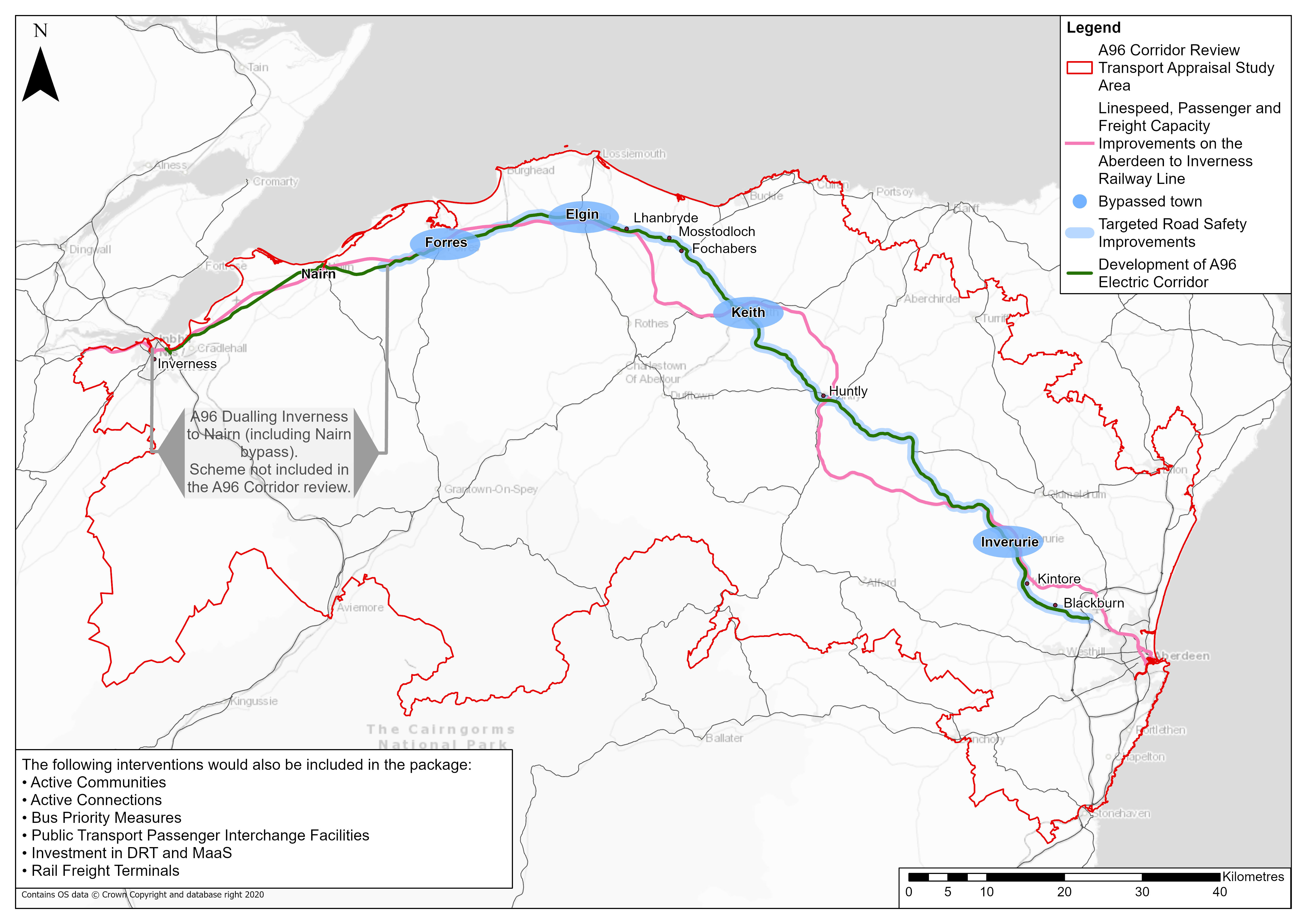
Figure 6‑6: Package 5 Extents
NaPTAT modelling shows that the improved journey time accessibility of educational premises would largely be observed in Aberdeenshire, where it is anticipated an additional 1,000 young people aged 16-24 would be able to access their nearest higher education site in approximately 60 minutes by public transport. These accessibility improvements would be linked to the rail linespeed improvements from the package, reducing the travel time to the cities where higher and further education sites are largely located. Further benefits would be provided from the improved interchange facilities and bus priority measures within the package, which would improve the connection between services or reduce journey times associated with bus. The largest journey time benefits would be experienced in rural settlements with access to rail stations, including Insch with a reduction of eight minutes and Alford
with a reduction of up to 17 minutes to the nearest site, though the latter would require undertaking part of the journey by bus, while parts of Kintore would experience a journey time benefit of up to six minutes.
In rural areas, children and young people may experience longer walks to bus stops, infrequent services and long waiting times for connecting services. An increase in DRT and MaaS could help to improve connectivity for children and young people, improving access to key services such as education. Improved connectivity could also result in improved personal safety and security through more direct services between origins and destinations. This improved provision would supplement the benefit of free bus travel for 5–22-year-olds with a National Entitlement Card (NEC). However, some children may still be excluded without the appropriate level of support to apply for a NEC.
While air quality modelling forecasts that this package would result in adverse air quality emissions over the 60-year appraisal period, there is potential for improvements in air quality in bypassed towns through a reduction of through traffic and an uptake of active travel, which could reduce traffic noise within the bypassed towns. This would be of particular benefit to children as they are more vulnerable to the adverse health effects of traffic-related emissions and noise. Reduced traffic levels could also help to address local severance issues, improve the active travel environment, reduce road safety concerns, and improve access to education for children and young people. In addition, the habit-forming effect of embedding active travel at a younger age has the potential to have longer-term benefits, in terms of moving to a more active population.
However, the construction of new bypasses could potentially result in negative impacts during both construction and operation stages for children living in local communities along the new alignment. This includes noise, vibration and air quality impacts during construction and potential severance, noise, air quality and traffic impacts during operation . However, the level of direct impact would be dependent on the alignment of the bypass and proximity to children and young people living or attending schools along the route. More detailed assessment is required at the design stage to understand the extent of these impacts and to recommend effective mitigation. Impacts would also depend on the level to which all other listed interventions can be adopted, as it is noted that this would depend on local circumstances within each key community .
The provision of, and improvements to, rail freight terminals is positive for children as they are particularly vulnerable to the effects of poor air quality. Transferring road freight to rail can contribute to a reduction in harmful NOx emissions, which would benefit this group. By reducing the volume of road traffic, safety could also be improved which would benefit children who are more vulnerable to fear of road danger. However, it should be noted that new rail freight terminals could lead to increased localised traffic, which could negatively impact air quality and road safety for children depending on where the rail terminals are located.
Overall, this package is expected to have a moderate positive impact under both the ‘With Policy’ and ‘Without Policy’ scenarios on addressing this criterion for children and young people.
Refined Package–Potential Impacts
The Refined Package is focused on primarily delivering transport network improvements to both settlements and rural sections throughout the A96 corridor, by providing enhancements which would aim to encourage a shift to sustainable modes, increasing opportunities for residents and businesses and improving road safety.
The options considered under the Refined Package are shown in Figure 6-7 .
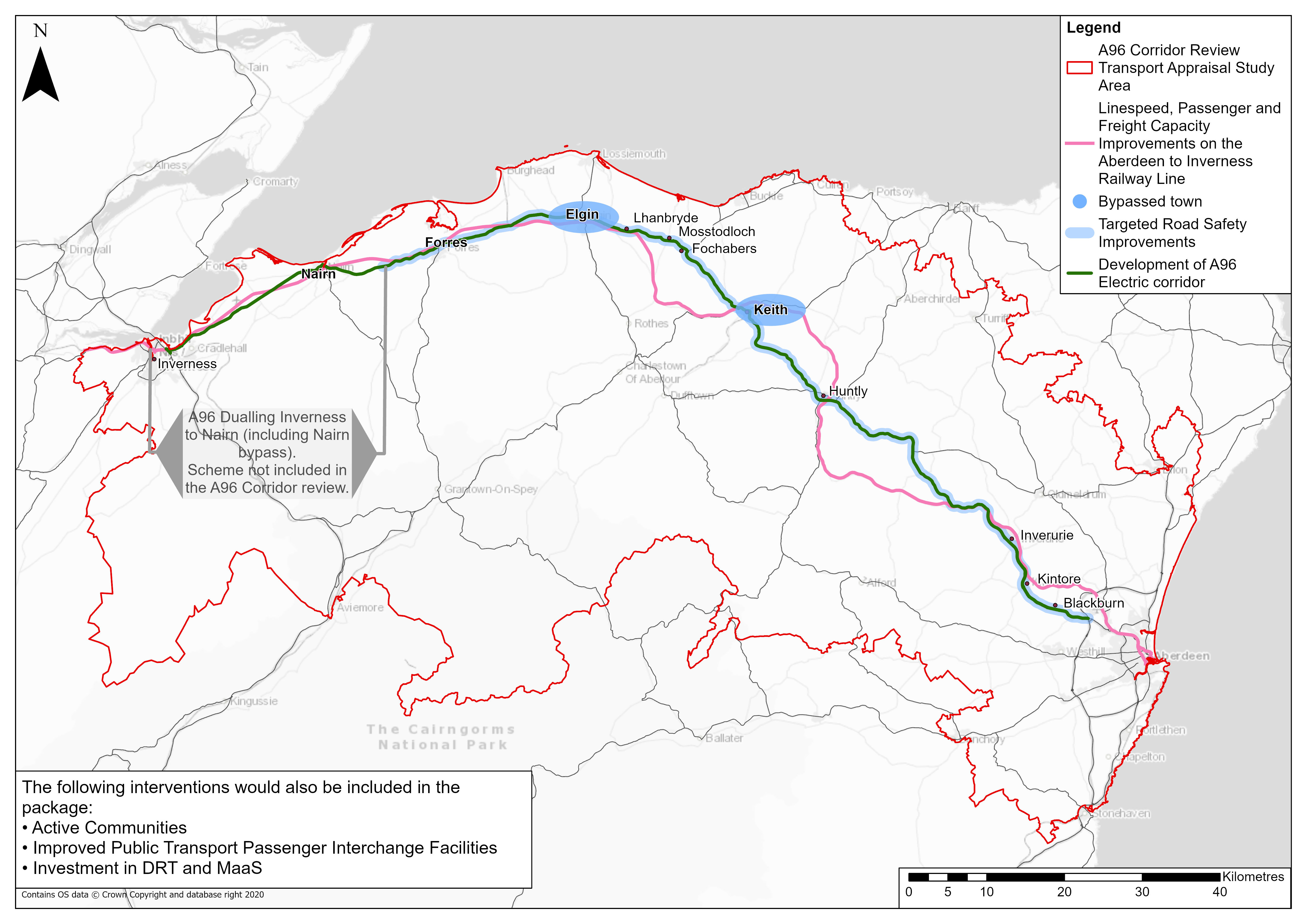
Modelling undertaken using NaPTAT suggests that this package would improve public transport journey time access to higher and further education for younger age groups in the study area.
NaPTAT modelling shows that the journey time accessibility benefits to education sites would largely be experienced in Aberdeenshire and is attributed to the rail intervention within this package. Rail interventions would reduce public transport journey times to Inverness and Aberdeen where the majority of higher and further
education sites are located. In Aberdeenshire, it is anticipated an additional 550 young people aged 16-24 would be able to access their nearest higher education within approximately 60 minutes by public transport. In addition, smaller settlements, such as Insch and Kintore, would be expected to experience a journey time reduction of up to eight and seven minutes respectively to the nearest higher education site, benefitting 600 young people.
In rural areas, children and young people may experience longer walks to bus stops, infrequent services and long waiting times for connecting services. An increase in DRT and MaaS could help to improve connectivity for children and young people, improving access to key services such as education. Improved connectivity could also result in improved personal safety and security through more direct services between origins and destinations. This improved provision would supplement the benefit of free bus travel for 5–22 year-olds with a National Entitlement Card (NEC). However, some children may still be excluded without the appropriate level of support to apply for an NEC.
Traffic modelling forecasts predict that traffic would divert away from the bypassed towns of Elgin and Keith, resulting in improved local air quality and reduced traffic noise within the towns. This would be of particular benefit to children as they are more vulnerable to the adverse health effects of traffic-related emissions and traffic noise. Reduced traffic levels could also help to address local severance issues, improve the active travel environment, reduce road safety concerns, and improve access to education for children and young people. In addition, the habit-forming effect of embedding active travel at a younger age has the potential to have longer-term benefits, in terms of moving to a more active population.
However, the construction of new bypasses could potentially result in negative impacts during both construction and operation stages for children living in, and in close proximity to, Elgin and Keith. This includes noise, vibration and air quality impacts during construction and potential severance, noise, air quality and traffic impacts during operation . However, the level of direct impact would be dependent on the alignment of the bypass and proximity to children and young people living or attending schools along the route. More detailed assessment is required as the design develops to understand the extent of these impacts and to recommend effective mitigation. Impacts would also depend on the level to which all other listed interventions can be adopted, as it is noted that this would depend on local circumstances within each key community.
The extent to which this package would improve outcomes for children would depend on the extent that the interventions listed are adopted, the location of the interventions, and proximity to local services.
This package is expected to have a moderate positive impact on this objective under both the ‘With Policy’ and ‘Without Policy’ scenarios .